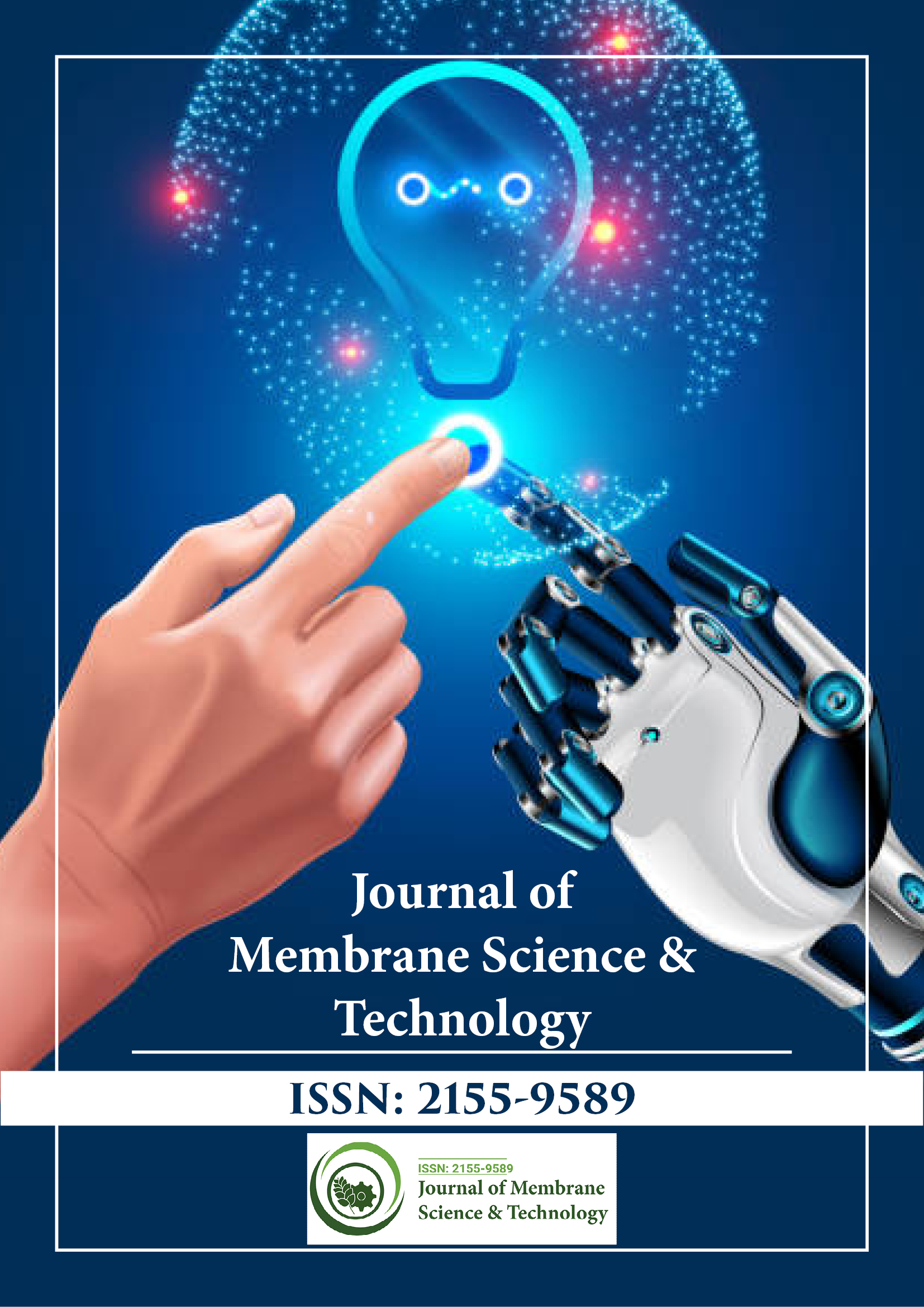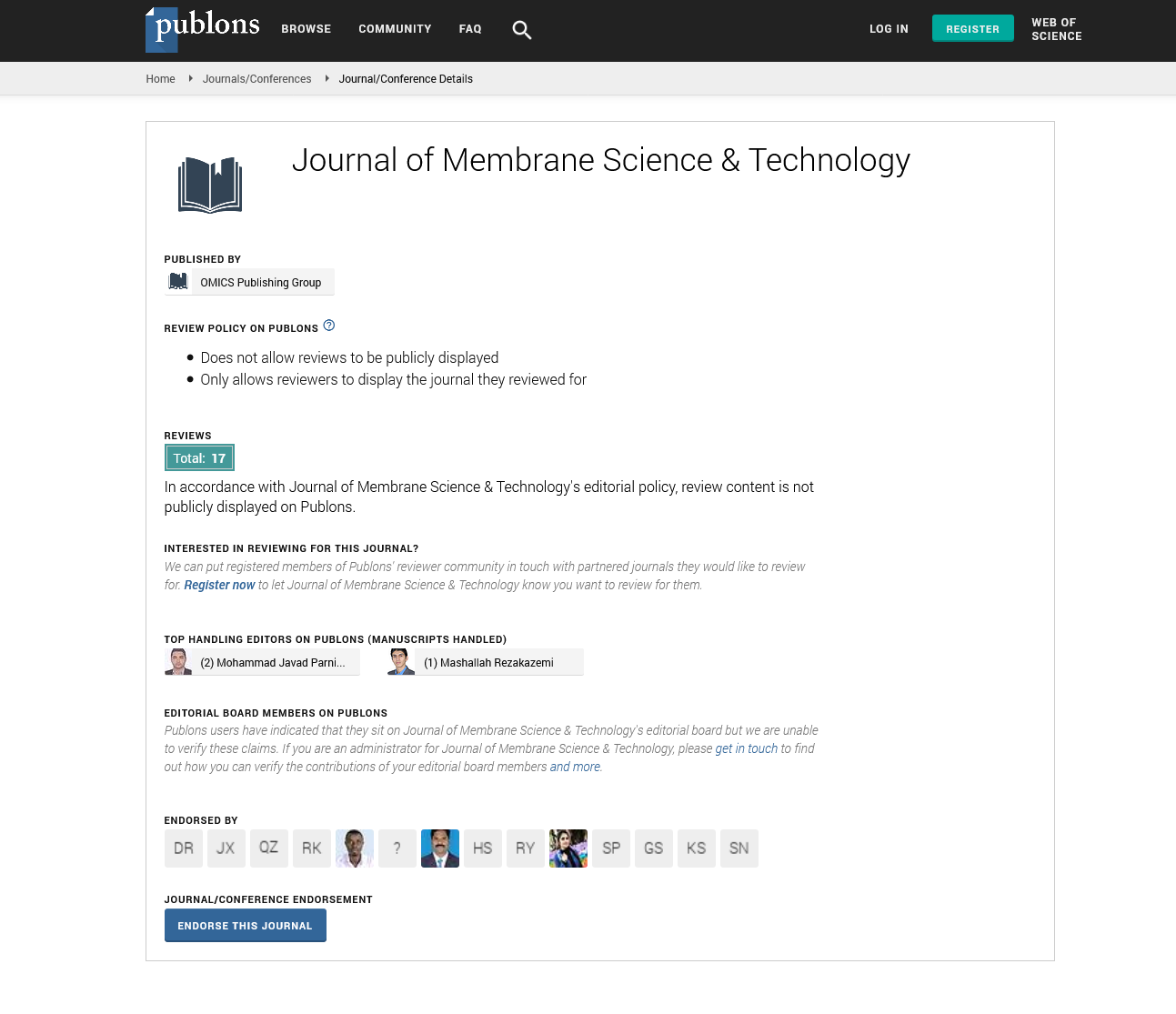Indexed In
- Open J Gate
- Genamics JournalSeek
- Ulrich's Periodicals Directory
- RefSeek
- Directory of Research Journal Indexing (DRJI)
- Hamdard University
- EBSCO A-Z
- OCLC- WorldCat
- Proquest Summons
- Scholarsteer
- Publons
- Geneva Foundation for Medical Education and Research
- Euro Pub
- Google Scholar
Useful Links
Share This Page
Journal Flyer

Open Access Journals
- Agri and Aquaculture
- Biochemistry
- Bioinformatics & Systems Biology
- Business & Management
- Chemistry
- Clinical Sciences
- Engineering
- Food & Nutrition
- General Science
- Genetics & Molecular Biology
- Immunology & Microbiology
- Medical Sciences
- Neuroscience & Psychology
- Nursing & Health Care
- Pharmaceutical Sciences
Commentry - (2025) Volume 15, Issue 2
Mechanisms, Impacts, and Control Strategies for Membrane Fouling in Filtration Systems
Shah Tanvir*Received: 30-Apr-2025, Manuscript No. JMST-25-29440; Editor assigned: 02-May-2025, Pre QC No. JMST-25-29440; Reviewed: 16-May-2025, QC No. JMST-25-29440; Revised: 23-May-2025, Manuscript No. JMST-25-29440; Published: 30-May-2025, DOI: 10.35248/2155-9589.25.15.422
Description
Membrane fouling is a significant and persistent challenge in membrane-based separation processes, affecting performance, operational efficiency and the longevity of membrane systems. It occurs when unwanted substances accumulate on the membrane surface or within its pores, leading to a decline in permeability, selectivity and overall system productivity. Membrane fouling affects various applications, including water and wastewater treatment, food and beverage processing, pharmaceutical production and chemical separations. Understanding the mechanisms of fouling, its consequences and effective control strategies is essential for optimizing membrane performance and reducing maintenance costs.
Fouling can be categorized based on the type of foulants involved, with the most common types being particulate fouling, organic fouling, biofouling and scaling (inorganic fouling). Each type of fouling results from different mechanisms and presents unique challenges in terms of detection, mitigation and removal. Particulate fouling involves the accumulation of suspended solids, colloids, or other insoluble particles on the membrane surface. These particles may come from raw feedwater or process streams and often result in the formation of a cake layer that reduces water flux. Over time, this layer can compact, further impeding flow and increasing pressure requirements. Pretreatment of feedwater through sedimentation, filtration, or coagulation can help reduce particulate fouling.
Organic fouling occurs when Natural Organic Matter (NOM), oils, greases, or industrial organics deposit onto or into the membrane. These substances can interact with the membrane material through hydrophobic interactions, hydrogen bonding, or electrostatic attraction. Organic fouling is particularly problematic in ultrafiltration and Nano filtration systems treating surface water or industrial effluents. It can lead to pore blockage, surface layer formation and significant permeability loss.
Biofouling, a more complex form of fouling, involves the growth and accumulation of microorganisms on the membrane surface, forming biofilms. Once microorganisms adhere to the membrane, they begin to multiply and excrete Extracellular Polymeric Substances (EPS), creating a sticky and resilient layer. Biofilms can severely impair membrane performance, increase pressure drop and reduce cleaning efficiency. Biofouling is especially common in water treatment and desalination systems and is difficult to control once established.
Scaling, or inorganic fouling, results from the precipitation and deposition of sparingly soluble salts, such as calcium carbonate, calcium sulfate, barium sulfate and silica. These salts can crystallize on the membrane surface or within the pores when their concentration exceeds the solubility limit, often due to temperature changes, pH shifts, or concentration polarization. Scaling is particularly prevalent in reverse osmosis systems operating at high recovery rates or treating hard water.
The consequences of membrane fouling are substantial and include decreased membrane flux, increased energy consumption, higher operating pressures, reduced membrane lifespan and frequent chemical cleaning. Additionally, fouling can alter membrane selectivity, leading to lower product quality or inconsistent separation results. In severe cases, irreversible fouling may require premature membrane replacement, contributing to higher operational costs and downtime.
Various strategies have been developed to control or mitigate membrane fouling. These strategies can be grouped into physical, chemical, operational and material-based approaches. Physical methods include backwashing, air scouring and membrane relaxation, which aim to dislodge and remove deposited foulants without chemical use. These methods are particularly effective for particulate and some biofouling issues in low-pressure membrane systems.
Chemical cleaning involves the use of acids, alkalis, detergents, or oxidants to dissolve or detach foulants from the membrane. Cleaning protocols are typically customized based on the fouling type and membrane material. For instance, acidic solutions are effective against scaling, while alkaline solutions target organic fouling. Biocides or disinfectants are used to control biofouling. However, frequent chemical cleaning can degrade membrane materials and increase operational costs, emphasizing the importance of preventive measures.
Operational strategies involve optimizing process parameters such as crossflow velocity, transmembrane pressure, recovery rate and feedwater pretreatment. Increasing crossflow velocity can reduce the thickness of the concentration polarization layer, minimizing the likelihood of fouling. Maintaining optimal pH and ionic strength can prevent salt precipitation and organic binding. Additionally, adjusting cleaning frequency and monitoring membrane performance through indicators like normalized flux or pressure drop can aid in early fouling detection and management.
Material-based solutions focus on modifying the membrane surface to resist foulant adhesion and accumulation. Hydrophilic surface modifications, such as grafting poly (ethylene glycol) or zwitterionic polymers, reduce interactions with hydrophobic organic matter and microbes. Embedding nanoparticles, such as silver, titanium dioxide, or graphene oxide, can impart antimicrobial properties, reduce biofouling and enhance mechanical strength. Some membranes are designed with super hydrophilic or super hydrophobic surfaces to create self-cleaning effects by promoting foulant detachment.
Recent advances in membrane technology are exploring smart or responsive membranes that can change their surface properties in response to environmental stimuli such as pH, temperature, or light. These membranes can potentially selfregulate fouling or trigger cleaning mechanisms when fouling begins to occur. Additionally, the integration of real-time fouling monitoring systems using sensors and data analytics is helping operators better predict and manage fouling events.
Conclusion
In conclusion, membrane fouling remains a major obstacle to the long-term efficiency and sustainability of membrane-based processes. Its complexity arises from the diverse nature of foulants and the interplay between membrane properties and operating conditions. Successful fouling control requires a combination of appropriate pretreatment, operational management, regular cleaning and membrane design. As research continues to deepen our understanding of fouling mechanisms and prevention techniques, the development of more resilient, self-cleaning and fouling-resistant membranes offers promising pathways to enhanced performance and reduced operational burden.
Citation: Tanvir S (2025) Mechanisms, Impacts and Control Strategies for Membrane Fouling in Filtration Systems. J Membr Sci Technol. 15:422.
Copyright: © 2025 Tanvir S. This is an open-access article distributed under the terms of the Creative Commons Attribution License, which permits unrestricted use, distribution and reproduction in any medium, provided the original author and source are credited.

